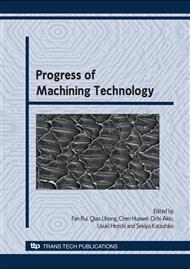p.504
p.509
p.516
p.521
p.528
p.533
p.538
p.545
p.550
Research on Warpage Deformation of Machining Cantilever Sheet Part with Combined Saw Milling Tool
Abstract:
Warpage deformation is an inevitable phenomenon as a cantilever sheet part is machined by combined saw milling tool. This problem affects machining quality obviously. In order to find the formation mechanism and a suitable solution, the paper carried out a qualitative analysis of the warpage causations, clarified the relationships of many factors and carried out quantitative analysis through the combined method of AdvantEdge FEM and Ansys. Furthermore, experiments of residual stress release and warpage solution were carried out in order to verify the correctness of theory analysis results. As is shown by the research results, warpage has already formed during residual stress formation. The causation of warpage is the unreasonable cutting path and the residual stress imbalance of the up and down sheet plane. The solution can control the warpage deformation well. The research results have an explicit guiding function to the actual production.
Info:
Periodical:
Pages:
528-532
Citation:
Online since:
February 2009
Authors:
Price:
Сopyright:
© 2009 Trans Tech Publications Ltd. All Rights Reserved
Share:
Citation:


